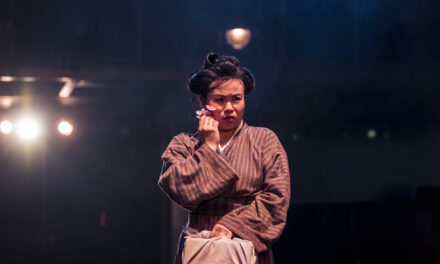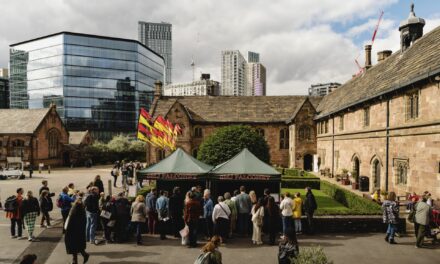I can’t stop thinking about Larksong. A few weeks ago, on a clear and mild autumn night, I travelled to Goodshaw Chapel, a nonconformist Baptist church established by textile workers and farm labourers in 1760, to see a new film installation incorporating music and poetry. Except ‘see’ isn’t the right word for what I experienced that evening. ‘Travelled’ isn’t right either given I could spot my house from the front step.
As a woman whose days of Saturday night clubbing, necking shots and stumbling home without a coat are long behind her, I love a local gig. It doesn’t get much more local than this, and probably not much prettier. Perched on the folds of the Rossendale moors, Goodshaw Chapel is owned by English Heritage. I’ve been itching to see inside for ages but viewings involve a chat with the enigmatically named ‘key keeper’ (um, Ghostbusters’ ‘keymaster’ anyone?), so this event, part of the British Textile Biennial 2023, was a golden opportunity.

Larksong. Photo by Jack Bolton.
At first, Larksong seemed like an odd juxtaposition of mediums. According to the blurb, artists Nick Jordan and Jacob Cartwright had used the chapel as ‘a central leitmotif’ (that’s a recurrent theme to you and me), and made a film which ‘captures the surrounding landscape of cloughs, rivers and moorlands, laced with the remnants and imprints of the textile workers and industries that shaped the environment’. There was a new poem by Emily Oldfield, written from the perspective of a chapel pew, and a musical score by David Chatton Barker, Mary Stark, Sam McLoughlin and Bridget Hayden. Added into the mix was a slew of traditional instruments, including a harmonium and recorder, but many of the sounds were derived from spinning wheels, hand looms and spindles.
But it worked, boy did it work. As the light faded and the box-pews, galleries and pulpit were cast into shadow, the silhouettes came into their own. A heady combination of foraged plants, carded cotton, raw wool and seed heads wove their own magic on the walls of the chapel, a mesmerising display accompanied by a spinner’s wheel plucking sounds seemingly at random yet, somehow, beautifully and hauntingly predetermined. Magic.

Larksong. Photo by Jack Bolton.
During an evening of quiet and subtle wonders, it’s hard to pick out the moment which shone most brightly. Perhaps the 19th century punch cards were the most moving – predecessors to modern computing, capable of producing complex textile patterns and, as I found to my surprise, tears of joy. The sheer simplicity of their outlines as they crawled across the ceiling, married with the echoing hush of the music, are imprinted on my brain. Whenever I think of them, I smile.
As a (fairly) new local resident, Larksong imbued me with a profound sense of place, not only of the landscape I see every day but with the reverberations of feet pounding the paths and roads centuries ago. Maybe this was intentional given the songs were inspired by manuscripts from the Larks of Dean choir, a group of 18th and 19th century musicians who carried their instruments over rough moorland terrain every Sunday to perform in Goodshaw Chapel.
It was only later, at home in my own converted chapel, that I read a tiny pamphlet handed to the (sold-out) audience. Inscriptions from gravestones found in the chapel’s burial grounds had been incorporated into the poetry and lyrics of Larksong, among them this, dedicated to Alice Maden of Nutshaw, who died 27.2.1836, aged 25 years:
‘Behold young man as you pass by,
As you are now so once was I,
As I am now, so you must be,
Therefore prepare to follow me.’
And so the tears came again.
By Helen Nugent, Editor of Northern Soul

Larksong. Photo by Jack Bolton.








